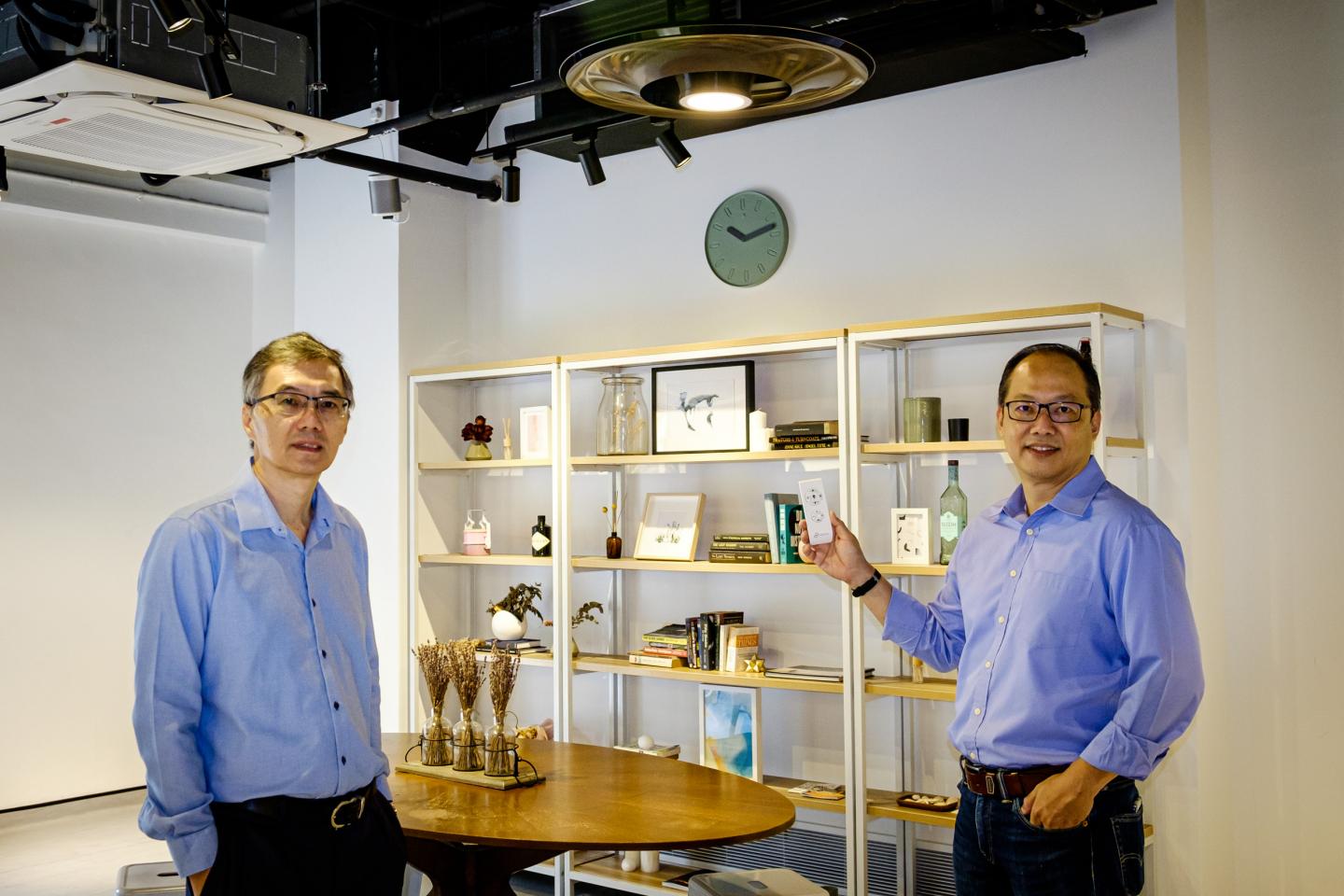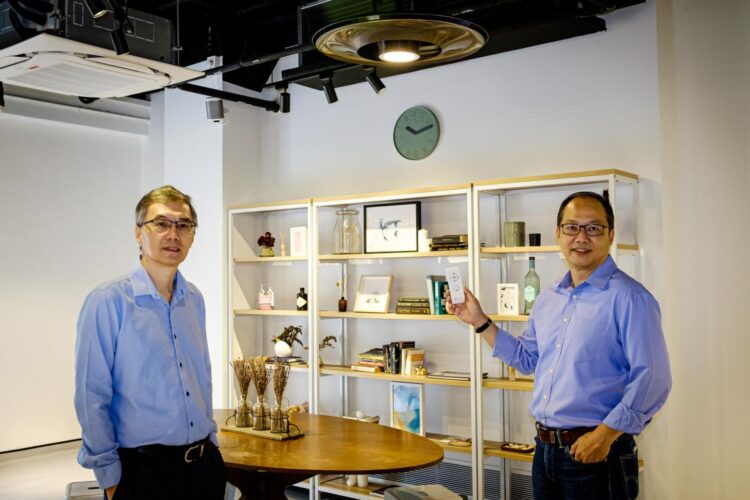
Credit: NTU Singapore
Vortec, a spin-off company from Nanyang Technological University, Singapore (NTU Singapore), has launched a new ceiling fan on Nov. 2, that uses half the energy of a conventional fan to cool a small room twice as quickly.
Based on original research by academics at NTU Singapore, the UFO-shaped fan is designed to harness the physical principle of a vortex, in which air is drawn up from below the fan and spins around a centre axis before being ejected from its top and dispersed around the edge of the room.
A typical ceiling fan consumes about 75 watts, compared to the 42 watts of the vortex fan, which due to its dual airflow generates twice as much air movement, at about 100 cubic metres per minute.
In the centre of the vortex fan is an LED (light emitting diode) lamp that provides light in different temperatures of white and an ultraviolet (UV) light source, which helps to kill micro-organisms such as bacteria and viruses that may contaminate the fan and reduce the spread of diseases through the air, in confined spaces.
The new fan is also safe to touch as it does not have any exposed fan blades and thus can be mounted lower than conventional fans on ceiling.
Named Vortec, the fan was designed at the Energy Research Institute @ NTU (ERI@N) and tested on the NTU Smart Campus, where it was installed at two F&B outlets and at the NTU Innovation Centre atrium.
Its inventor is ERI@N co-director Choo Fook Hoong, a leading expert in the field of energy management, data analytics and air-conditioning systems.
“When moisture and heat are wicked away from the skin by wind or air flow, that makes us feel cool. Conventional fans with multiple blades only blow air downwards and those who are at the peripheries of its range won’t feel as cool as people underneath it,” explains Mr Choo, who is also the Founder and Executive Director of Vortec.
“We reversed the physics, so underneath our fan, the cooler air on the ground of a room is drawn upwards, wicking away heat and moisture from those sitting underneath it, so they feel cool. Then the fan throws the air outwards from the top of the spinning vortex to create an air curtain that falls and cools people at the periphery with its circular airflow.”
The UV LED lamp equipped on the Vortec is produced by Seoul Viosys, a global innovator of UV LED products and technology which are used widely for sterilisation and disinfection purposes. In lab tests, Seoul Viosys and Sensor Electronic Technology, Inc., together with a research group from Korea University, announced that they have been successful in achieving 99.9 per cent sterilisation of the coronavirus (COVID-19).[1]
To cool down larger rooms, such as the Connect71 Co-Op Café at the NTU Innovation Centre which is the size of a four-room apartment (90 sqm), four Vortec fans were installed and are now replacing the use of four air conditioning units.
Used in conjunction with the building’s Passive Displacement Ventilation System – where cool air from the condensers sinks and hot air rises to the top to be cooled – the café has managed to reduce utility costs by an estimated 50 per cent.
NTU student Crystal Mak who works as a Manager at Connect71 Café, reviewed the new fans after they were installed for a month, saying that the efficient circulation and volume of wind from the Vortec fans had cooled down their customers without disrupting the café ambience due to its silent operations, at an optimal 23 degrees Celsius.
“The fans seamlessly blend into the background of the cafe, are visually aesthetic and add value to the interior design look we were going for. They also help the café to keep up with the technologically sophisticated ambience of the Innovation Centre where we are situated,” adds the Year 2 maths student.
Mr Soh Yong Joo, Managing Director of the Crowded Bowl, an F&B outlet located the NTU North Spine Plaza, said the four new fans installed in his shop reduced the need from two air-conditioning units to just one: “Vortec helped us to reduce our electricity bill by half and yet is able to maintain the coolness and comfort of our shop, enhancing the dine-in experience for our customers.”
The made-in-NTU vortex technology took over two years to develop at ERI@N and is protected by a technology disclosure and a patent filed by NTUitive, NTU’s innovation and enterprise company, in 2013.
The idea of using a vortex to generate air flow was first conceptualised by Prof Choo about ten years ago, who has deep expertise in heating, ventilation, and air conditioning systems. First designed virtually via a computer model, the fan model was then simulated and assessed using Computational Fluid Dynamics (CFD).
Following the promising results, the researchers then fabricated various small prototypes of the promising designs, before selecting the best performing design to be made into a full-size fan made from cardboard – where vanes were hand cut and glued together into a circular piece.
With the success of the cardboard version, the second full-size prototype was fabricated using plastics with the support from the Multidisciplinary Team Project (MDT) – known as the “Vortex Ventilator” in 2015. A commercial model of this fan was developed in 2017 and saw several units being deployed and used in Singapore MRT train stations (Bugis and Raffles) supported by Temasek Foundation Ecosperity from 2018 to 2019.
Dr Alex Lin, Interim CEO of NTUitive, said: “Vortec is a great example of how university research can be translated and brought to the market rapidly through NTUitive’s start-up incubation programme, where we help accelerate the commercialisation process through support in areas such as Intellectual Property and office space, as well as to groom entrepreneurs and pair them up with technology most suited for their businesses.”
###
The Vortec fans are now on sale on various e-commerce platforms such as Shopee, where buyers can opt for self-installation or a scheduled installation.
[1] To view the findings from Seoul Viosys and Sensor Electronic Technology, Inc on their lab test results see below.
Media contact:
Lester Kok
Assistant Director
Corporate Communications Office
Nanyang Technological University
Tel: 6790 6804; Mobile: 9741 5593
Email: [email protected]
About Nanyang Technological University, Singapore
A research-intensive public university, Nanyang Technological University, Singapore (NTU Singapore) has 33,000 undergraduate and postgraduate students in the Engineering, Business, Science, Humanities, Arts, & Social Sciences, and Graduate colleges. It also has a medical school, the Lee Kong Chian School of Medicine, established jointly with Imperial College London.
NTU is also home to world-renowned autonomous institutes – the National Institute of Education, S Rajaratnam School of International Studies, Earth Observatory of Singapore, and Singapore Centre for Environmental Life Sciences Engineering – and various leading research centres such as the Nanyang Environment & Water Research Institute (NEWRI) and Energy Research Institute @ NTU (ERI@N).
Ranked amongst the world’s top universities by QS, NTU has also been named the world’s top young university for the last seven years. The University’s main campus is frequently listed among the Top 15 most beautiful university campuses in the world and it has 57 Green Mark-certified (equivalent to LEED-certified) building projects, of which 95% are certified Green Mark Platinum. Apart from its main campus, NTU also has a campus in Singapore’s healthcare district.
Under the NTU Smart Campus vision, the University harnesses the power of digital technology and tech-enabled solutions to support better learning and living experiences, the discovery of new knowledge, and the sustainability of resources.
For more information, visit http://www.
Media Contact
Lester Kok
[email protected]
Original Source
https:/





